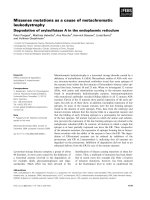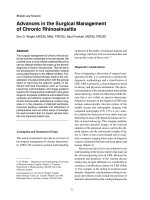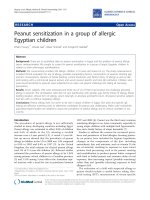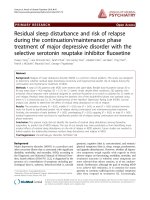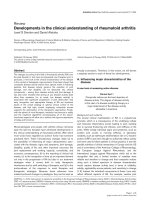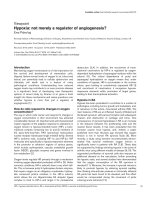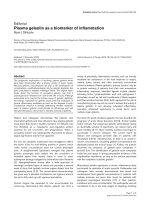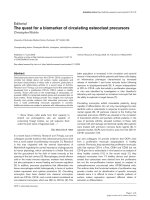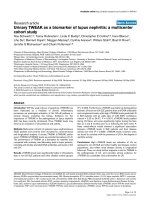Báo cáo y học: " Obstructive sleep apnoea: a cause of chronic cough" ppt
Bạn đang xem bản rút gọn của tài liệu. Xem và tải ngay bản đầy đủ của tài liệu tại đây (241.5 KB, 5 trang )
BioMed Central
Page 1 of 5
(page number not for citation purposes)
Cough
Open Access
Research
Obstructive sleep apnoea: a cause of chronic cough
Surinder S Birring*
3
, Alvin J Ing
1
, Kevin Chan
1
, Gavina Cossa
1
,
Sergio Matos
2
, Michael DL Morgan
2
and Ian D Pavord
2
Address:
1
Respiratory Investigation Unit, Concord Hospital, Sydney, Australia,
2
Institute for Lung Health, Department of Respiratory Medicine,
Glenfield Hospital, Leicester, UK and
3
Department of Respiratory Medicine, King's College Hospital, London, UK
Email: Surinder S Birring* - ; Alvin J Ing - ; ;
Gavina Cossa - ; Sergio Matos - ; Michael DL Morgan - ;
Ian D Pavord -
* Corresponding author
Abstract
Chronic cough is a common reason for presentation to both general practice and respiratory
clinics. In up to 25% of cases, the cause remains unclear after extensive investigations. We report
4 patients presenting with an isolated chronic cough who were subsequently found to have
obstructive sleep apnoea. The cough improved rapidly with nocturnal continuous positive airway
pressure therapy. Further studies are required to investigate the prevalence of coexistence of these
common conditions.
Background
Chronic cough is one of the commonest reasons for pres-
entation to respiratory clinics. Investigations are usually
aimed at identifying the three most common causes of
chronic cough: cough variant asthma, gastro-oesophageal
reflux and upper airway cough syndrome. [1] In up to
25% of patients, the cause of cough remains unexplained
after extensive investigations and treatment trials. [2-4]
Patients experience considerable physical and psycholog-
ical morbidity. Here, we report 4 well-characterised
patients referred to a general respiratory clinic with unex-
plained chronic cough who were subsequently found to
have obstructive sleep apnoea.
Case presentations
Patient 1
A 52-year-old financial advisor was referred by his general
practitioner with a 3-month history of productive cough.
He described a severe barking cough that occurred both in
the day and night time and was exacerbated by lying flat,
strong odours and smoky atmospheres. He was prescribed
multiple courses of antibiotics, which were unhelpful. He
also complained of mild dyspnoea on climbing hills but
no wheezing. He had longstanding left nasal congestion
without post-nasal drip following a broken nose in child-
hood and mild symptoms of gastro-oesophageal reflux.
He had been diagnosed with hypertension and hypercho-
lesterolaemia two years previously for which he was pre-
scribed Bendroflumethiazide, Valsartan, Doxazoscin and
Cervistatin. He was an ex-smoker and accumulated a 15
pack-year smoking history. His clinical examination and
physical findings were normal. Initial spirometry and
chest radiograph were within normal limits (Table 1). His
cough was thought to be due to gastro-oesophageal reflux
and rhinitis so he was started on a prolonged course of
topical nasal steroids and high dose proton pump inhibi-
tor. Methacholine airway challenge test, induced sputum
eosinophil cell count, high resolution computerised tom-
ography (HRCT) scan and echocardiogram arranged to
investigate asthma, eosinophilic bronchitis, bronchiecta-
sis and left ventricular dysfunction were all normal (Table
1).
Published: 2 July 2007
Cough 2007, 3:7 doi:10.1186/1745-9974-3-7
Received: 19 March 2007
Accepted: 2 July 2007
This article is available from: />© 2007 Birring et al; licensee BioMed Central Ltd.
This is an Open Access article distributed under the terms of the Creative Commons Attribution License ( />),
which permits unrestricted use, distribution, and reproduction in any medium, provided the original work is properly cited.
Cough 2007, 3:7 />Page 2 of 5
(page number not for citation purposes)
On review 6 and 12 months later his symptoms of rhinitis
and gastro-oesophageal reflux had resolved but his cough
persisted. No explanation for the cough was found and he
discharged back to his general practitioner. He was re-
referred back to the clinic 3 years later with daytime som-
nolence, lethargy, apnoeas and cough. In retrospect, he
had mild daytime somnolence and lethargy at the time of
initial presentation. He was noted to have a small
oropharynx on external examination. Polysomnography
was arranged that was consistent with the diagnosis of
obstructive sleep apnoea (Table 1). Nocturnal nasal con-
tinuous positive airway pressure (CPAP) therapy was
commenced and he noticed an immediate improvement
in cough and daytime somnolence. His cough resolved
entirely within 6 weeks and he remains free of cough 12
months later. The initiation of CPAP therapy has also led
to a reduction in anti-hypertensive medications and com-
plete resolution of oxygen desaturation on repeat sleep
study.
Patient 2
A 73 year-old housewife with an 18-month history of
severe chronic cough was referred by her respiratory phy-
sician for a second opinion. The cough was predomi-
nantly dry, interfered with her daily activities and
occasionally disturbed her sleep. She did not report other
respiratory symptoms, postnasal drip or gastro-oesopha-
geal reflux. Her past medical history consisted of diabetes,
hypertension, atrial fibrillation and aorto-femoral bypass
for peripheral vascular disease. Soon after the onset of
cough, she was diagnosed as having severe obstructive
sleep apnoea with full polysomnography after admitting
to symptoms of daytime somnolence, snoring and dis-
turbed sleep (Table 1). She could not be persuaded to try
CPAP therapy or alternative options and was more con-
cerned about the chronic cough. She was an ex-smoker
and stopped smoking 13-years previously, accumulating a
40-pack year smoking history. Clinical examination and
chest radiograph were normal. Spirometry was consistent
with a moderate restrictive defect consistent with obesity.
Treatment trials with inhaled corticosteroids, short and
long acting bronchodilators and high dose proton pump
inhibitors were unsuccessful. Nasendoscopy, Ear-Nose-
Throat evaluation, echocardiogram (normal left ventricu-
lar function) and bronchoscopy were normal. She had
marked impairment of quality of life secondary to chronic
cough as assessed with the Leicester Cough Questionnaire
(Figure 1) and increased cough frequency measured with
the Leicester Cough Monitor, a 24-hour ambulatory auto-
mated cough detection monitor (Figure 2). [5-7] She
agreed to try CPAP therapy at a subsequent follow-up
clinic. She was admitted for a CPAP titration study and a
pressure of 12 cm H
2
o abolished snoring and apnoeas.
She noticed a significant improvement in cough at the end
of the first week on CPAP therapy. There was an 80%
reduction in objective cough frequency at 6-weeks (672 vs
141 coughs per 24-hours) and a significant improvement
in cough specific quality of life (Improvement in LCQ
Table 1: Patient characteristics
Patient 1 Patient 2 Patient 3 Patient 4
Age (years) 52 73 46 63
Gender (m/f) MF F M
Snoring Yes Yes Yes Yes
Nocturnal cough Yes Yes Yes Yes
Body mass Index (Kg/m
2
) 35 32 37 33
Baseline cough VAS 90 95 50 80
Post CPAP cough VAS 050 0
Cough duration at OSA diagnosis (mo) 48 6 16 8
FEV
1
(%predicted) 93 61 119 100
FEV
1
/FVC (%) 78 70 84 83
PC
20
mg/ml) >16 nd >16 >16
Sputum neutrophil (nr <65%) 89 - 91 87
Sputum eosinophil (nr <2%) 0.3 - 1.4 0.5
ESS preCPAP 71415 15
ESS post CPAP 387 5
AHI baseline (per hour) 36 86 62 10 (4% SpO
2
dips)
SpO
2
(4% dips/hour) on CPAP 0.7 0 3 0
CPAP (cm H
2
o) 12 12 8 6
CPAP compliance (mean hours/night) 647 6
NR: normal range; VAS: visual analogue score (0–100 mm worst); CPAP: continuous positive airway pressure; OSA: obstructive sleep apnoea; FEV
1
:
forced expiratory volume; FVC: forced vital capacity; PC
20
: provocative concentration of methacholine causing >20% decline in FEV
1
; ESS: daytime
Epworth Sleepiness Scale (range 0–24, nr<11); AHI: apnoea hypopnoea index (nr< 5/hour); SpO
2
: oxygen saturation
Cough 2007, 3:7 />Page 3 of 5
(page number not for citation purposes)
total score 8.2 which was greater than the LCQ minimal
important difference of 1.3; Figures 1 and 2). She was able
to resume regular activities after improvement of her
cough.
Patient 3
A 46-year-old nurse was referred by her occupational
health physician with a 1-year history of productive
cough. The cough occurred through the day and night and
there were no specific triggers or associated symptoms.
There were no symptoms of dyspnoea or wheeze. She did
not complain of symptoms suggestive of rhinitis or gastro-
oesophageal reflux. A trial of inhaled corticosteroids and
nasal steroids were unhelpful. Her husband commented
that she recently started snoring but he had not witnessed
apnoeas. She complained of lethargy that was associated
with mild somnolence. She had pneumonia in childhood
but was unable to give further details. Her past medical
history was otherwise unremarkable. She had never
smoked and did not consume alcohol. On examination,
she had evidence of retrognathia but was otherwise unre-
markable. Chest radiograph and spirometry were within
normal limits.
The initial differential diagnosis was cough secondary to
asthma, eosinophilic bronchitis or bronchiectasis. Metha-
choline airway challenge test, induced sputum eosinophil
cell count and HRCT were arranged and were normal
(Table 1). Partial polysomnography (RM60 study: air-
flow, chest wall movement, oximetry, snoring, pulse) was
subsequently arranged because of mild somnolence and
snoring, which was highly suggestive of obstructive sleep
apnoea. Nocturnal nasal CPAP therapy was commenced
and she noticed an immediate improvement in cough,
lethargy and somnolence. The cough resolved within 5
days and she remains free of cough 15 months later.
Repeat sleep study indicates complete resolution of oxy-
gen desaturation on CPAP.
Patient 4
A 63-year-old office worker with the police force was
referred by his general practitioner with a 4-month history
of chronic productive cough. The cough was severe,
occurred both day and night time and was worse lying
flat. There were no dyspnoea, wheeze or symptoms sug-
gesting gastro-oesophageal reflux and rhinitis. He was an
ex-smoker with less than 2 pack year smoking history and
did not consume alcohol. His past medical history was
unremarkable. Clinical examination, chest radiograph
and spirometry were normal.
The cause of cough was not clear. Methacholine airway
challenge test and induced sputum eosinophil cell count
were normal (Table 1). At 4-month review he complained
of snoring and daytime somnolence. A pulse oximetry
sleep study was arranged which was consistent with a
diagnosis of obstructive sleep apnoea. The cough and
sleepiness improved significantly with nocturnal nasal
CPAP after 2 days and the cough resolved completely 3
months later. At 15-month review after initiation of CPAP
therapy, the patient does not complain of cough or som-
nolence.
Discussion
We report for the first time, four adult patients with
obstructive sleep apnoea that presented with a chronic
cough. All patients had a rapid improvement of cough
Decrease in cough frequency following CPAP in patient 2 assessed with the Leicester Cough Monitor (LCM)Figure 2
Decrease in cough frequency following CPAP in patient 2
assessed with the Leicester Cough Monitor (LCM).
0
10
20
30
40
50
60
70
80
90
100
09 10 11 12 13 14 15 16 1718 19 20 21 22 23 24 01 02 03 04 05 06 07 08
Pre-CPAP
Post-CPAP
Time
Coughs
Improvement in cough specific quality of life after (continu-ous positive airway pressure) CPAP therapy in patient 2Figure 1
Improvement in cough specific quality of life after (continu-
ous positive airway pressure) CPAP therapy in patient 2. (a)
Leicester Cough Questionnaire (LCQ) Domain scores.
(Higher score = better quality of life: QOL) (b) LCQ total
score. (Minimal important difference 1.3; higher score = bet-
ter QOL).
0
1
2
3
4
5
6
Physical Psychological Social
Pre-CPAP
Post-CPAP
LCQ score
LCQ Domain
0
2
4
6
8
10
12
14
16
LCQ TOTAL score
Pre-CPAP Post-CPAP
(a)
(b)
Cough 2007, 3:7 />Page 4 of 5
(page number not for citation purposes)
with CPAP therapy and are free of respiratory symptoms
twelve months later. This suggests a link between cough
and obstructive sleep apnoea in these patients.
Obstructive sleep apnoea was not apparent at presenta-
tion in our patients. The initial investigations were
directed at determining the aetiology of chronic cough
using a standardised diagnostic algorithm. [8] These
patients underwent assessment for the most common
causes of chronic cough in non-smokers with normal
chest radiograph and spirometry which are considered to
be asthma, rhinitis and gastro-oesophageal reflux disease.
None of our patients were taking angiotensin converting
enzyme inhibitors. Daytime somnolence was present at
initial consultation but this was not reported by patients
or recognised by the physician. This symptom may have
been masked by the severity of the cough and not consid-
ered by the physician since obstructive sleep apnoea is not
a recognised cause of chronic cough. It is only when typi-
cal symptoms of obstructive sleep apnoea became appar-
ent or progressed that polysomnography was requested
and the diagnosis of obstructive sleep apnoea established.
The lack of clinical suspicion of obstructive sleep apnoea
at presentation with cough led to considerable delays in
diagnosis and was over 3 years in one patient. Once CPAP
therapy was initiated, there was a rapid improvement of
cough and symptoms of obstructive sleep apnoea within
days. This is consistent with a case report of a three-year-
old boy with chronic cough, snoring and upper airway
obstruction on polysomnography in whom there was res-
olution of cough after commencing CPAP therapy. [9]
Patients with obstructive sleep apnoea and cough are
likely to have upper airway injury and inflammation
resulting from snoring and frequent episodes of airway
obstruction. Snoring and obstructive sleep apnoea cause
airway epithelial damage and inflammatory cell infiltra-
tion of the lamina propia. [10] Our patients had a raised
sputum neutrophil count consistent with inflammation
in the large airways. [11] Patients with obstructive sleep
apnoea have raised concentrations of inflammatory medi-
ators in the upper airways that may sensitize cough recep-
tors leading to heightened cough reflex sensitivity
analogous to that seen in cough due to asthma and eosi-
nophilic bronchitis. [12,13] Interestingly, subjects who
snore are more likely to report a cough supporting the
mechanism of airway injury causing cough in obstructive
sleep apnoea. [14-18] It is possible that the cough may
have resulted from mechanical causes and independently
of airway inflammation since the effect of CPAP was
rapid. Bonnet et al have described 5 patients with noctur-
nal cough and increased airway collapsibility secondary to
bronchomalacia that responded to CPAP therapy. [19] It
is possible that this condition may have co-existed in our
patients with obstructive sleep apnoea.
Another potentially important mechanism of cough in
patients with obstructive sleep apnoea is gastro-oesopha-
geal reflux associated cough. Obstructive apnoea episodes
increase trans-diaphragmatic pressure that may lead to
insufficiency of the gastric cardia and lower oesophageal
sphincter. [20] There is a higher incidence of gastro-
oesophageal reflux in patient with obstructive sleep
apnoea and CPAP therapy has been shown to reduce epi-
sodes of gastro-oesophageal reflux. [21,22] Another possi-
bility is that CPAP therapy may have be effective at
reducing nocturnal gastro-oesophageal reflux and associ-
ated cough independent of the presence of obstructive
sleep apnoea. Only patient 1 reported symptoms of gas-
tro-oesophageal reflux but his cough persisted despite a
trial of high dose proton pump inhibitor. Gastro-
oesophageal reflux associated cough cannot be categori-
cally excluded in our patients because we did not measure
24-hour oesophageal pH or assess for the presence of non-
acid gastro-oesophageal reflux and this requires further
study. Another possible cause of cough in our patients is
rhinitis although none had symptoms or evidence of rhin-
itis on external examination at the time of diagnosis.
However, "silent" rhinitis cannot be fully excluded in our
patients. Finally, a general abnormality of upper airway
reflexes is possible that leads to reduced upper airway tone
and calibre and loss of inhibitory pathways of the cough
reflex. [23]
Limitations of our study are the small number of patients
studied and the diagnoses of obstructive sleep apnoea
were based on limited polysomnography and oximetry
study in two cases. It is unlikely that these studies are false
positives since both patients did not have a history of
chronic obstructive pulmonary disease or heart failure
where false positive studies are often seen. Furthermore,
these studies are considered acceptable first line diagnos-
tic studies in recent guidelines. [24] We are confident that
our patients had obstructive sleep apnoea since they had
suggestive symptoms and good clinical and objective
response to CPAP therapy. We were able to utilise recently
available objective cough assessment tools in patient 2 to
validate the presence of a frequent cough associated with
impaired quality of life and a clinically significant
improvement with CPAP therapy. [5-7] This study sug-
gests that objective coughing monitoring tools may be
useful and responsive in patients with chronic cough and
this requires confirmation in larger numbers.
Cough is likely to be a common symptom in patients pre-
senting with obstructive sleep apnoea. The prevalence of
obstructive sleep apnoea in patients presenting with a
chronic cough is not known and deserves further study.
The cause of cough remains unexplained in up to 30% of
subjects referred to specialist cough clinics despite exten-
sive investigations and it is likely that obstructive sleep
Publish with BioMed Central and every
scientist can read your work free of charge
"BioMed Central will be the most significant development for
disseminating the results of biomedical research in our lifetime."
Sir Paul Nurse, Cancer Research UK
Your research papers will be:
available free of charge to the entire biomedical community
peer reviewed and published immediately upon acceptance
cited in PubMed and archived on PubMed Central
yours — you keep the copyright
Submit your manuscript here:
/>BioMedcentral
Cough 2007, 3:7 />Page 5 of 5
(page number not for citation purposes)
apnoea is missed in some cases. It is important to recog-
nise this condition early because of its implications for
driving and operating machinery and associated cardio-
vascular morbidity if left untreated. CPAP is a very effec-
tive therapy for obstructive sleep apnoea associated
cough, is well tolerated and resolution of cough was seen
in all patients. Our preliminary series indicates that there
is an association between cough and obstructive sleep
apnoea. Placebo controlled trials with CPAP will need to
be performed to establish the value of this treatment
modality for obstructive sleep apnoea related cough.
Competing interests
The author(s) declare that they have no competing inter-
ests.
Authors' contributions
SSB conceived of the study, and participated in its design
and coordination and wrote the manuscript. AJI, KC and
GC participated in subject recruitment and clinical charac-
terisation, and application of cough monitoring tech-
niques to this study. SM participated in the cough
monitoring of patients. MDLM and IDP participated in
subject recruitment, clinical characterisation, analysis and
writing up of the manuscript. All authors read and
approved the final manuscript.
Funding
none
Acknowledgements
We thank DD Vara (Head, Department of Respiratory Physiology, Glen-
field Hospital) and Peter Rodgers (Head, Respiratory Function Unit, Con-
cord Hospital) for assistance in characterisation of some of the patients.
References
1. Irwin RS, Baumann MH, Bolser DC, Boulet LP, Braman SS, Brightling
CE, Brown KK, Canning BJ, Chang AB, Dicpinigaitis PV, Eccles R,
Glomb WB, Goldstein LB, Graham LM, Hargreave FE, Kvale PA,
Lewis SZ, McCool FD, McCrory DC, Prakash UB, Pratter MR, Rosen
MJ, Schulman E, Shannon JJ, Smith Hammond C, Tarlo SM, American
College of Chest Physicians (ACCP): Diagnosis and management
of cough executive summary: ACCP evidence-based clinical
practice guidelines. Chest 2006, 129(1 Suppl):1S-23S.
2. McGarvey LP, Heaney LG, Lawson JT, Johnston BT, Scally CM, Ennis
M, Shepherd DR, MacMahon J: Evaluation and outcome of
patients with chronic non-productive cough using a compre-
hensive diagnostic protocol. Thorax 1998, 53:738-743.
3. Haque RA, Usmani OS, Barnes PJ: Chronic idiopathic cough: a
discrete clinical entity? Chest 2005, 127:1710-1713.
4. Birring SS, Brightling CE, Symon FA, Barlow SG, Wardlaw AJ, Pavord
ID: Idiopathic chronic cough: association with organ specific
autoimmune disease and bronchoalveolar lymphocytosis.
Thorax 2003, 58:1066-1070.
5. Birring SS, Prudon B, Carr AJ, Singh SJ, Morgan MD, Pavord ID:
Development of a symptom specific health status measure
for patients with chronic cough: Leicester Cough Question-
naire (LCQ). Thorax 2003, 58:339-43.
6. Matos S, Birring SS, Pavord ID, Evans DH: Detection of cough sig-
nals in continuous audio recordings using hidden Markov
models. IEEE Transactions on Biomedical Engineering 2006,
53:1078-83.
7. Birring SS, Matos S, Patel RB, Prudon B, Evans DH, Pavord ID: Cough
frequency, cough sensitivity and quality of life in patients
with chronic cough. Resp Med 2006, 100:1105-9.
8. Brightling CE, Ward R, Goh KL, Wardlaw AJ, Pavord ID: Eosi-
nophilic bronchitis is an important cause of chronic cough.
Am J Respir Crit Care Med 1999, 160:406-410.
9. Teng AY, Sullivan CE: Nasal mask continuous positive airway
pressure in the treatment of chronic nocturnal cough in a
young child. Respirology 1997, 2:131-134.
10. Paulsen FP, Steven P, Tsokos M, Jungmann K, Muller A, Verse T, Pirsig
W: Upper airway epithelial structural changes in obstructive
sleep-disordered breathing. Am J Respir Crit Care Med 2002,
166:501-509.
11. Pizzichini E, Pizzichini MM, Efthimiadis A, Evans S, Morris MM, Squil-
lace D, Gleich GJ, Dolovich J, Hargreave FE: Indices of airway
inflammation in induced sputum: reproducibility and validity
of cell and fluid-phase measurements. Am J Respir Crit Care Med
1996, 154:308-317.
12. Goldbart AD, Goldman JL, Veling MC, Gozal D: Leukotriene mod-
ifier therapy for mild sleep-disordered breathing in children.
Am J Respir Crit Care Med 2005, 172:364-370.
13. Birring SS, Parker D, Brightling CE, Bradding P, Wardlaw AJ, Pavord
ID: Induced sputum inflammatory mediator concentrations
in chronic cough. Am J Respir Crit Care Med 2004, 169:15-19.
14. Lu LR, Peat JK, Sullivan CE: Snoring in preschool children: prev-
alence and association with nocturnal cough and asthma.
Chest 2003, 124:587-593.
15. Nelson S, Kulnis R: Snoring and sleep disturbance among chil-
dren from an orthodontic setting. Sleep Breath 2001, 5:63-70.
16. Corbo GM, Fuciarelli F, Foresi A, De Benedetto F: Snoring in chil-
dren: association with respiratory symptoms and passive
smoking. BMJ 1989, 299:1491-1494.
17. Bloom JW, Kaltenborn WT, Quan SF: Risk factors in ageneral
population for snoring. Importance of cigarette smoking and
obesity. Chest 1988, 93:678-683.
18. Larsson LG, Lundback B, Jonsson E, Lindberg A, Sandstorm T: Are
symptoms of obstructive sleep apnoea syndrome related to
bronchitic symptoms or lung function impairment? Report
from obstructive lung disease in North Sweden study. Respir
Med 1998, 92:283-8.
19. Bonnet R, Jorres R, Downey R, Hein H, Maggnussen H: Intractable
cough associated with the supine position body position.
Chest 1995, 108:581-585.
20. Demeter P, Pap A: The relationship between gastroesophageal
reflux disease and obstructive sleep apnea. J Gastroenterol 2004,
39:815-820.
21. Gislason T, Janson C, Vermeire P, Plaschke P, Bjornsson E, Gislason
D, Boman G: Respiratory symptoms and nocturnal gastro-
esophageal reflux: a population-based study of young adults
in three European countries. Chest 2002, 121:158-63.
22. Ing AJ, Ngu MC, Breslin AB: Obstructive sleep apnea and gastro-
esophageal reflux. Am J Med 2000, 108:120-125.
23. Kimoff RJ, Sforza E, Champagne V, Ofiara L, Gendron D: Upper air-
way sensation in snoring and obstructive sleep apnea. Am J
Respir Crit Care Med 2001, 164:250-255.
24. SIGN: Management of obstructive sleep apnoea/hypoapnoea
syndrome in adults. 2003:1-35.
